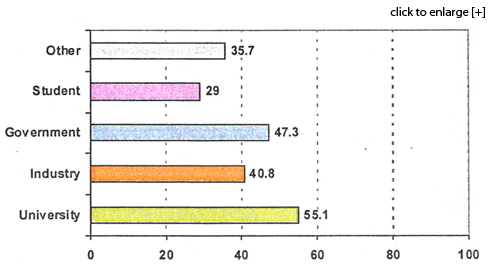ASA Meetings Survey Results
However, as indicated in Figure 2, almost 45% have attended at least one major meeting in statistics (not sponsored by ASA). Figure 3 indicates that a majority of these respondents are university affiliated and government affiliated (55.1% and 47.3% respectively) comparing to industry affiliated and students (40.8% and 29%, respectively).
Expansion on special topics of interest and outside the United States
In regard to expansion of ASA’s sponsoring of thematic meetings on special topics of interest, almost 58% of the respondents agreed it would be a good idea (40.3% somewhat agree and 17.8% definitely agree). Also, regarding expansion to sponsor meetings outside the United States, almost 45% agree (27.1% somewhat agree and 17.5% definitely agree), as indicated in Table 2.
(1) Do you agree that ASA should expand its sponsorship of thematic meetings on special topics of interest?
(2) Almost all of ASA’s meetings are held in the U.S. Do you agree that ASA should pursue opportunities to sponsor meetings outside the U.S., perhaps jointly with other statistical societies?
As indicated in Table 3, affiliation does not materially influence attitude toward the expansion of the ASA’s efforts in sponsoring thematic meetings on special topics of interest. But in terms of expansion outside the United States, students and university affiliated members feel more strongly about it (Table 4).
Membership Benefits
The membership benefit most often identified as important or very important (84% of respondents) is statistical knowledge gained through ASA publications. Knowledge shared through conferences was also important or very important to most respondents (76%). Professional identity and networking were important or very important to about 67% of respondents. Knowledge shared through workshops was considered important or very important to 56% of respondents.
More than two-thirds of respondents report belonging to other major professional associations. Of those, 17% reported their primary involvement was with the ASA, whereas 36% reported being involved in the ASA and other organizations. Almost half (48%) reported that they are primarily involved with another organization or that they are not involved in any of the associations to which they belong (i.e., they’re not really involved with the ASA, despite being members).
Involvement varied significantly by location with those outside the United States being less likely to be primarily involved with the ASA (19% for U.S., 6% non-U.S.). There were no significant differences by gender, but the age of the respondent plays a big role. Those born after 1979 (respondents under 30) are much less likely to be involved in any association to which they belong (43% compared to overall 23%). Age of respondent was more related to this response than years of membership in the ASA, though these two variables are likely to be strongly correlated. This finding represents a potential focus of further research—the future of the ASA depends on its ability to attract and retain student and early career statisticians or practitioners.





















